2018 TOYOTA PROACE ECU
[x] Cancel search: ECUPage 242 of 516

242
In the event of a fault with the adaptive cruise control, you are alerted by an audible signal and display of the message message "Driving aid functions fault".Have the system checked by an authorized Toyota dealer or repairer, or another duly qualified and equipped professional.
Operating faultThe adaptive cruise control operates by day and at night, in fog or moderate rainfall.
When the cruise control is working, take care if making a maintained press on one of the cruise control programmed speed modification buttons: this can lead to a very quick change in the speed of your vehicle.Do not use the adaptive cruise control on slippery sur faces or in heavy traffic.
When descending a steep hill, the cruise control may not be able to prevent the vehicle from exceeding the programmed speed.When ascending a steep hill or when towing, it might not be possible to achieve or maintain the programmed speed.
The use of mats not approved by Toyota may inter fere with the operation of the adaptive cruise control.To avoid any risk of jamming the pedals:- ensure that mats are secured c o r r e c t l y,- never fit one mat on top of another.It is recommended that you always keep
your feet close to the pedals.
If the difference between the programmed speed setting and the speed of the vehicle in front is too great, the speed cannot be adjusted: the cruise control is automatically deactivated.
The system does not act on the braking system, but works only with engine braking.The regulation range is limited: there will no longer be any adjustment of speed if the difference between the programmed speed setting and the speed of the vehicle in front becomes too high.
The adaptive cruise control cannot in any circumstances replace the observation of speed limits, nor the need for the vigilance on the part of the driver.
Driving
Page 271 of 516

271
Accessories
A wide range of accessories and genuine parts is available from the Toyota dealer network.These accessories and parts are all suitable for your vehicle and benefit from Toyota's recommendation and warranty.
"Comfort"
Door deflectors, cigarette lighter, boot dividers, coat hanger fixed to head restraint, front and rear parking sensors, styling mudflaps, boot management system, ...
"Transport solutions"
Boot liners, roof bars, bicycle carrier on roof bars, ski carrier, roof box, towbar harness, ....Tow bar, which must be fitted by an authorized Toyota dealer or repairer, or another duly qualified and equipped professional.
"Styling"
Wheel trims, wheel caps, door sills, gear lever knobs, ...
"Security and safety"
Anti-theft alarm, window engraving, wheel security bolts, child seats, breathalyzer, first aid kit, warning triangle, high visibility jacket, stolen
vehicle tracking system, fleet management unit, snow chains, tyre snow socks, front foglamps kit, ...
"Protection"
Mats*, seat covers compatible with lateral airbags, mud flaps, side protection rubbing strips, bumper protectors, loading area protection (on wood or plastic), rear sill finishers, rear mat, ....
The fitting of electrical equipment or accessories which are not recommended by Toyota may result in a failure of your vehicle's electronic system and excessive electrical consumption.Contact a Toyota dealer for information on the range of recommended equipment and accessories.
Installation of radio communication transmitters
Before installing any after-market radio communication transmitter, you can contact a Toyota dealer for the specification of transmitters which can be fitted (frequency, maximum power, aerial position, specific installation requirements), in line with the Vehicle Electromagnetic Compatibility Directive (2004/104/EC).
Depending on the legislation in force in the country, certain safety equipment may be compulsory: high visibility safety vests, warning triangles, breathalyzers, spare bulbs, spare fuses,
fire extinguisher, first aid kit, mud flaps at the rear of the vehicle.* To avoid any risk of jamming of the pedals:- ensure that the mat is positioned and secured correctly,- never fit one mat on top of another.
7
Practical information
Page 273 of 516

273
Roof bars / Roof rack
To fit the transverse roof bars, use the fixing points provided for this purpose:F open the fixing covers on each bar,F put each fixing in place and lock them on the roof one by one,F ensure that roof bars are correctly fitted (by shaking them),F close the fixing covers on each bar.The bars can be interchanged and are adaptable to each pair of fixing points.
To fit a roof rack, use the fixing points provided for this purpose:F place the roof rack on the roof aligned with the fixing points and secure each one in turn,F ensure that roof rack is correctly fitted (by shaking it).
Be sure to refer to national legislation in order to comply with the regulations for transporting objects that are longer than the vehicle.
Maximum authorised weight on each fixing point, for a loading height not exceeding 40 cm: 25 kg.Maximum weight by vehicle size:- compact (L1) with 8 fixing points: 200 kg- standard (L2) and long (L3) with 10 fixing points: 250 kgIf the height exceeds 40 cm, adapt the
speed of the vehicle to the profile of the road to avoid damaging the roof rack or roof bars and the fixing points on the roof.
Front mud flaps, rear mud flaps...Screenwash, replacement fuses, wiper blades, interior and exterior cleaning and maintenance products, replacement bulbs...
To prevent the mat from becoming caught under the pedals:- ensure that the mat and its fixings are positioned c o r r e c t l y,- never fit one mat on top of another.Audio equipment, hands-free kit, speakers, navigation...Regardless of the audio and telematic equipment offered on the market, the technical constraints linked with the fitting of equipment of these families of products mean that the special features of the equipment and its compatibility with the capacities of the your vehicle's standard equipment must be taken into account. Please contact a dealer for information before fitting such equipment.
For any work on your vehicle, use a qualified workshop that has the technical information, skills and equipment required, all of which a Toyota dealer is able to provide.
7
Practical information
Page 287 of 516
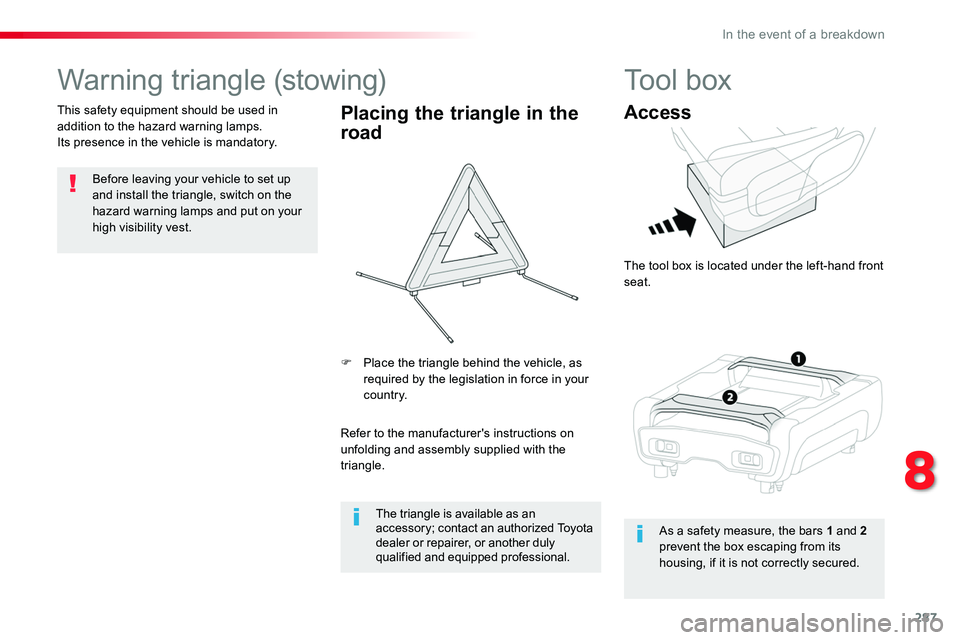
287
Warning triangle (stowing)
Before leaving your vehicle to set up and install the triangle, switch on the hazard warning lamps and put on your
high visibility vest.
This safety equipment should be used in addition to the hazard warning lamps.Its presence in the vehicle is mandatory.
Placing the triangle in the
road
Refer to the manufacturer's instructions on unfolding and assembly supplied with the triangle.
F Place the triangle behind the vehicle, as required by the legislation in force in your c o unt r y.
The triangle is available as an accessory; contact an authorized Toyota dealer or repairer, or another duly qualified and equipped professional.
Tool box
Access
The tool box is located under the left-hand front seat.
As a safety measure, the bars 1 and 2
prevent the box escaping from its housing, if it is not correctly secured.
8
In the event of a breakdown
Page 288 of 516
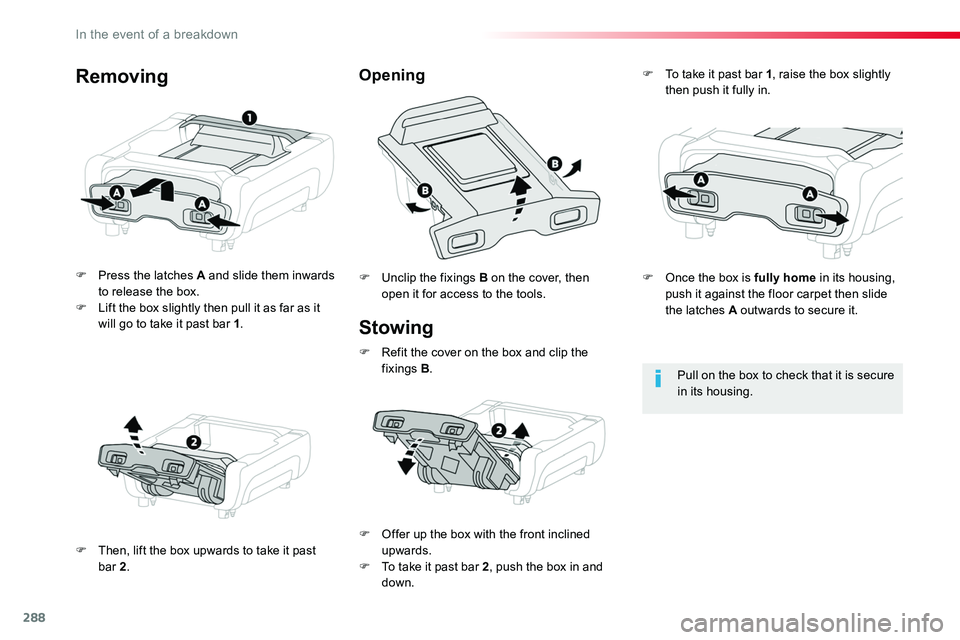
288
Stowing
F Press the latches A and slide them inwards to release the box.F Lift the box slightly then pull it as far as it will go to take it past bar 1.
F Then, lift the box upwards to take it past bar 2.
F Unclip the fixings B on the cover, then open it for access to the tools.
OpeningRemoving
Pull on the box to check that it is secure in its housing.
F Offer up the box with the front inclined upwards.F To take it past bar 2, push the box in and down.
F To take it past bar 1, raise the box slightly then push it fully in.
F Refit the cover on the box and clip the fixings B.
F Once the box is fully home in its housing, push it against the floor carpet then slide the latches A outwards to secure it.
In the event of a breakdown
Page 289 of 516
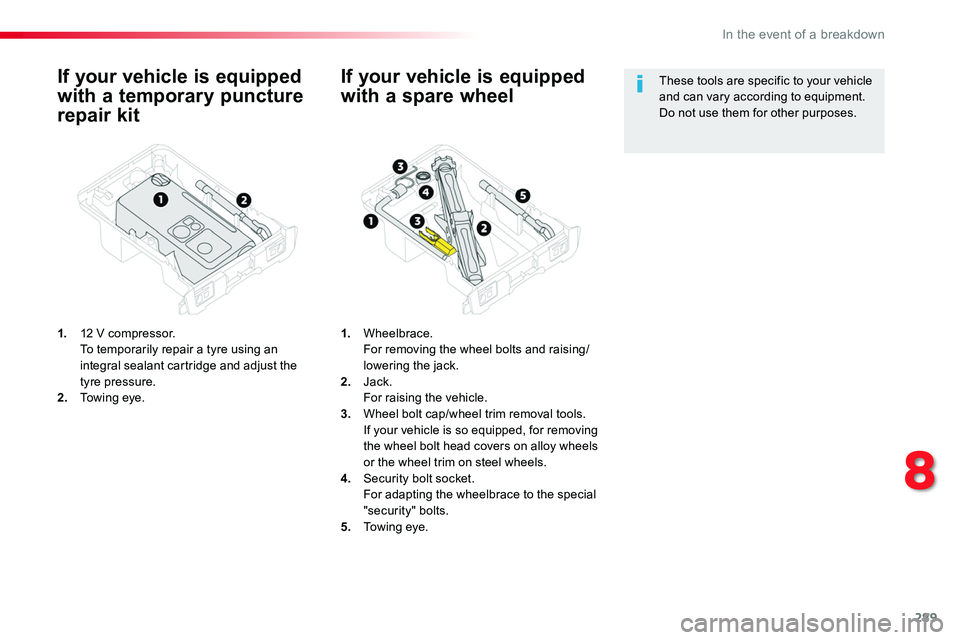
289
If your vehicle is equipped
with a temporary puncture
repair kit
1. 12 V compressor. To temporarily repair a tyre using an integral sealant cartridge and adjust the tyre pressure.2. Towing eye.
If your vehicle is equipped
with a spare wheel
1. Wheelbrace. For removing the wheel bolts and raising/lowering the jack.2. Jack. For raising the vehicle.3. Wheel bolt cap/wheel trim removal tools. If your vehicle is so equipped, for removing the wheel bolt head covers on alloy wheels or the wheel trim on steel wheels.4. Security bolt socket. For adapting the wheelbrace to the special "security" bolts.5. Towing eye.
These tools are specific to your vehicle and can vary according to equipment. Do not use them for other purposes.
8
In the event of a breakdown
Page 296 of 516
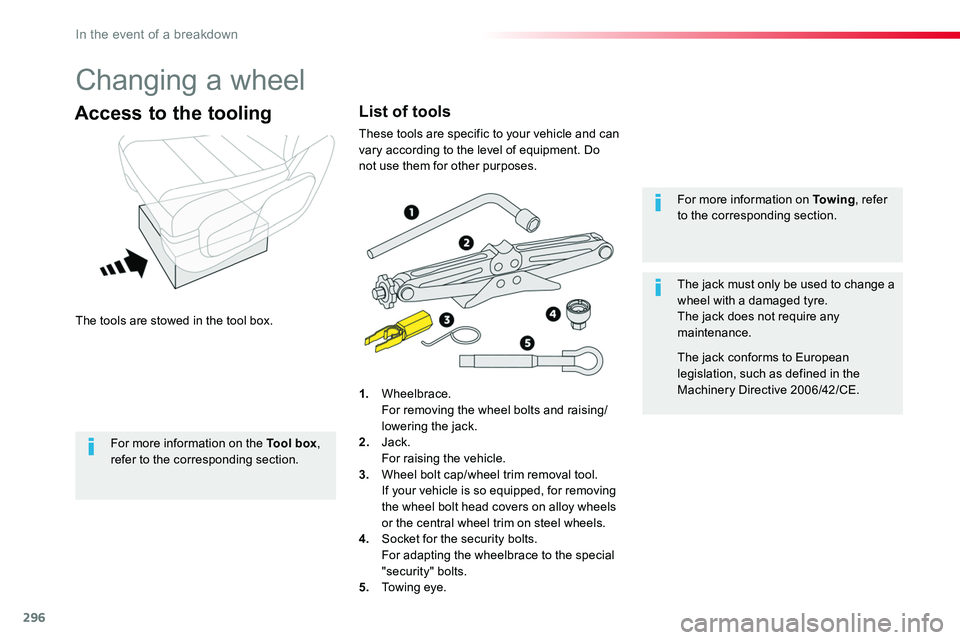
296
Changing a wheel
The tools are stowed in the tool box.
Access to the tooling
1. Wheelbrace. For removing the wheel bolts and raising/lowering the jack.2. Jack. For raising the vehicle.3. Wheel bolt cap/wheel trim removal tool. If your vehicle is so equipped, for removing the wheel bolt head covers on alloy wheels or the central wheel trim on steel wheels.
4. Socket for the security bolts. For adapting the wheelbrace to the special "security" bolts.5. Towing eye.
For more information on To w i n g, refer to the corresponding section.
The jack must only be used to change a wheel with a damaged tyre.The jack does not require any maintenance.
The jack conforms to European legislation, such as defined in the Machinery Directive 2006/42/CE.
List of tools
These tools are specific to your vehicle and can vary according to the level of equipment. Do not use them for other purposes.
For more information on the Tool box, refer to the corresponding section.
In the event of a breakdown
Page 299 of 516
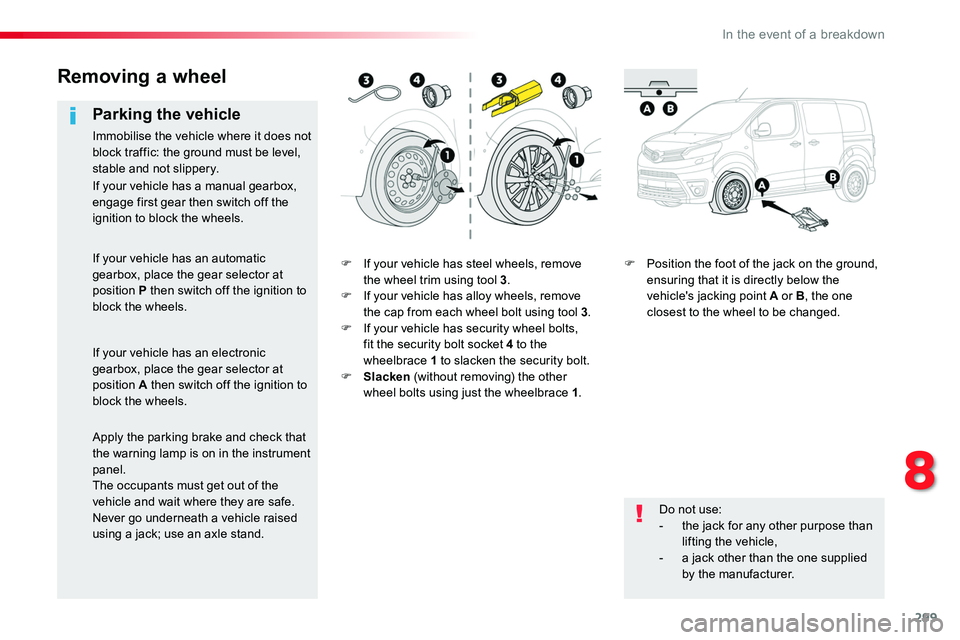
299
F If your vehicle has steel wheels, remove the wheel trim using tool 3.F If your vehicle has alloy wheels, remove the cap from each wheel bolt using tool 3.F If your vehicle has security wheel bolts, fit the security bolt socket 4 to the wheelbrace 1 to slacken the security bolt.F Slacken (without removing) the other wheel bolts using just the wheelbrace 1.
F Position the foot of the jack on the ground, ensuring that it is directly below the vehicle's jacking point A or B, the one closest to the wheel to be changed.
Removing a wheel
Parking the vehicle
Immobilise the vehicle where it does not block traffic: the ground must be level, stable and not slippery.
Do not use:- the jack for any other purpose than lifting the vehicle,- a jack other than the one supplied by the manufacturer.
If your vehicle has a manual gearbox, engage first gear then switch off the ignition to block the wheels.
If your vehicle has an automatic gearbox, place the gear selector at position P then switch off the ignition to block the wheels.
If your vehicle has an electronic gearbox, place the gear selector at position A then switch off the ignition to block the wheels.
Apply the parking brake and check that the warning lamp is on in the instrument panel.The occupants must get out of the vehicle and wait where they are safe.Never go underneath a vehicle raised using a jack; use an axle stand.
8
In the event of a breakdown